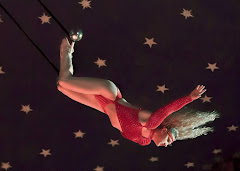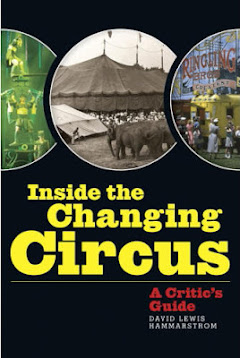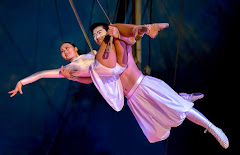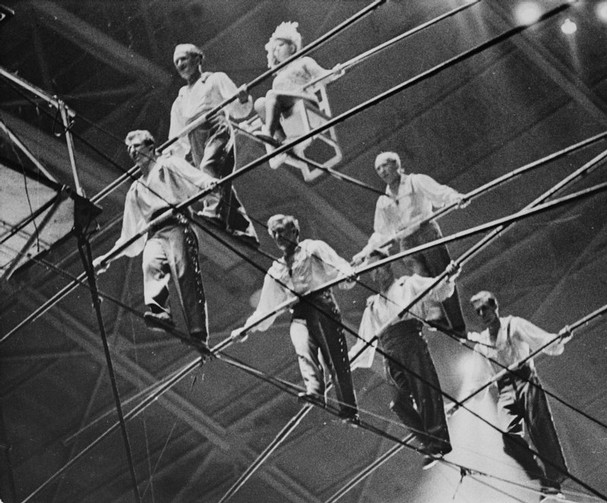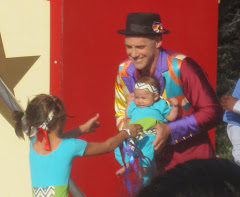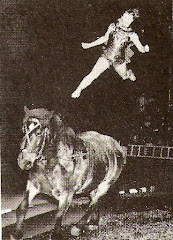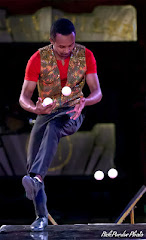Timothy Tegge, practically born in greasepaint, is many things in a world he sees fast disappearing — circus clown, ringmaster for Royal Hanneford, collector and historian, producer and performer, and more. He is currently working on a piece about Ringling photographer Ted Sato for Bandwagon. And he will be hosting his own mini-convention of fans, Central States Circus Soiree, at his home in Baraboo, July 9-11.
When I caught up with him to chat about his take on the book, Queen of the Air: A True Story of Love and Tragedy, Tim was at the wheel of his truck, heading east on one of the interstates to visit three locations, each offering a circus collection that might be “mediocre" or might yield some golden goodies.
I first met Tim during better,
happier times for American circus, during its last great decade – make that the
excellent 80s. It was on a sunny Monday
morning in Los Angeles at Philippes restaurant, sawdust on the floor, where fans and pros gathered
weekly to share spangled memories and to dish out the latest gossip. I was then
at work on a book about John Ringling North, and Tim virtually offered to help
supply photographs, which he did. And
which he would do for another of mine, Inside the Changing Circus. He always came through.
How far away, those wonderful days, days we took for granted. The circus they represented is now, at best, a pale and dying shadow of itself, and this Tim and I would face. But first, about the Lillian Leitzel and Alfredo Codona tome, a work which I may have prematurely and stupidly acclaimed.
Timothy, in fact, is something of an expert on the Codona-Leitzel story, having written his own book on the subject, and thus would be in a far better position than I to judge Queen of the Air’s overall historical accuracy. So I reached out to him. On my own, I had found an ominous number of troubling assertions in Dean Jensen’s text, not the least being a gigantic blunder in giving credit for the first triple somersault to Ernest Clarke rather than to Lena Jordan. Might Tim have found others?
Indeed, he did. And we are not
talking number of tent poles or sunburst wagon wheels. We are talking the lives
and affairs of two legendary circus stars.
The holder of over two hundred letters, contracts, etc.
by Codona and Leitzel–Vera Bruce, Tim’s biggest letdown was the author’s
failure, in his view, to capture the true spirit of their relationship. Of
course, interpretation of such matters is always partly subjective.
Okay, let’s test his complaint anyway. I mentioned how astonished I was that Lilian had kept Alfredo waiting over three hours at the alter on their wedding day. Not possible, replied Tim. “They were married between shows in Chicago.”
Indeed, if you believe in the work of Fred Bradna (The Big Top), and author Robert Taylor (Center Ring), that is what happened. At a post wedding reception after the show, Leitzel lost herself in the crowd, perhaps suffering from opening night jitters, and for a couple of hours, Codona went nearly mad trying to find his brand new spouse. Fearing she had already strayed? BTW: Does anybody believe those two actually went for the whole Honeymoon package? Okay, maybe a token once, and then never again.
I mentioned to Tim how, according to Jensen, Codona begged and begged and begged Vera Bruce, who flew in his act, to marry him. This
was, of course, after Leitzel had taken her fatal fall. Tim could not see that happening. It was the
other way around. Bruce, wanting to
outshine Leitzel as an aerialist, had been after Alfredo. I have all along assumed that a woman in her
position would have likely done just that.
In fact, a year into his marriage
to Leitzel, according to Bradna, Codona had
become “emotionally involved” with co-flyer Bruce, seen above with him, and
thus was a triangle born. “To steal
Leitzel’s husband was a triumph for her.” Their marriage ended in tragedy, when Codona first took a gun on Bruce, only 32-years-old, and then aimed it at himself.
All of which lends credence to Tim’s belief that Jensen saw a great movie in the story and “sensationalized” his narrative in order to enhance its marketability to movie producers. So we are talking something closer to a historical novel, which is what I vaguely assumed the book to be when I first heard of its coming out and of its being compared to Water for the Elephants. If this is so, Jansen performed a con job on the American media and book world. Shame on his publisher, Crown, for daring to call it a “biography.”
I have reread parts of the book, and am revising my review. I will not be placing Queen of the Air high on my list, in fact anywhere on my list of favorite circus tomes. A novel is a novel is a novel. And this book ill-serves the cause of history by being so blatantly misrepresented and sold to the pubic. How I looked forward to buying my own copy and reading it again. How gone is that feeling.
In fact, to venture into its pages again, I would feel myself treading a minefield of hard fact and dubious misinformation, at every turn wondering, did that really happen. And still wondering how in the world Jensen could have overlooked a key component in Leitzel's extravagant showmanship: Willie Mosher, the 6' 4" footman attired as a doorman, who escorted the 4' 9" Great One into the ring, and sometimes carried her out following one of her notoriously staged fainting spells. His name is nowhere n the index, nor do I recall reading of him. How did the author miss that? And ... what else might he have missed - or botched?
Where We Are Now -- If Anywhere?
How quickly good intentions fall under troubled big tops. Dr. Neil Kahanovitz lasted barely more than a single season of shining hope, trying to bring Big Apple Circus out of bankruptcy. His successor lasted not much longer. Circus lords are a rare breed.
Timothy Tegge is as much realist as an enthused exhibitor of circus history, of which he has assembled a formidable collection, sometimes taking parts of it on the road. The White Tops editors, valuing Tegge's "insider status,” asked him if he would “look into his crystal” ball and write a realistic piece for the magazine. Tim did just that. I have read the piece, thoroughly first rate, striking a fine balance between realism and hope.
The editors received his prose with rapture.
Came the eve of publication, and Tim received an e-mail from the same editors
informing him that they hadn’t the room to fit his piece into the issue,
but invited him to “revise” and resubmit
with more upbeat photos. He walked away,
obviously unimpressed. I would suggest
the CFA needs an overhaul.
Is the American circus dead, I
asked Tim, still at the wheel, still heading east. “It’s been on seriously shaky grounds
over the last 20 years,” he
answered. On life support? “That’s a good way of putting it.” Perhaps what bothers him the most is how a
new generation is viewing the circus as “no longer important,” but a relic of
another time.
Okay, I press him for specifics on a few of shows:
Big Apple Circus?
“Gone.” He caught the last edition produced by the
new owners on Easter
Sunday 2019, up in a
suburb of Boston. It
was “a good show,” he granted, but rather average. Their biggest failure in
Tim’s opinion is marketing. He recalls people touring with
the BAC show reporting around 20
people in the seats during
the weeknights, and half houses at best on the weekend, the same, he
learned for other dates,
as well, including Lincoln Center.
A Ringling Return?
He doubts that Kenneth Feld might revive the circus,
as he promised to do a couple of years back
Feld is no longer a young man, and he would “have to start all over from
scratch,” nor can Tim see the daughters being able to carry on, were their father
up to such a herculean challenge. Our ringmaster at the wheel figures that the
Ringling press release touting a return (which not a single media outlet
picked up) may have been simply an
action necessary to legally retain possession of the show’s famous title.
“When you say ‘the greatest show on earth,’ people think elephants and tigers.” In other words, literally they can’t bring it back.
UinverSoul Circus?The big winner. Maybe the “the only show that can capture the major city market nowadays, certainly more so than Soleil,”pipes the man at the wheel, "and it's a very good show!" Very interesting, Tim. We agree on this: they can play the race card to the hilt — Black owned! Black owned! Black owned! And maybe out-woke the wrath of PETA. Cedric Walker has a loyal audience base among African Americans, and no doubt the groveling support of all Woke movements everywhere that together have been tearing down American big tops for years. I myself truly believe that American culture — “tree hugging morons, ”in Tim’s words — brought down the circus.
Carson and Barnes?
He is not so sure. Tim can see two new forms emerging: For one,
the Byrds offering a circus attraction the year around in Hugo, thus switching
from touring show to tourist town. Keeping their elephants “safe
and at home,” and sparing themselves the stress of moving them across state
lines and “sweating out individual state authorities acting out a witch hunt”.
Two: a new template for American circus, returning to the original form we “adopted “ from the Brits. A one ring with horses and ponies, enhanced with modern technology. Sounds a little like what Big Apple in its better Binder days was kind of doing.
Tim with wife Barbara, daughter of foot juggler Miss Loni, whose act she continues on. You've seen Miss Lonie in DeMille's The Greatest Show on Earth.
 There will come a day, Timothy
Tegge believes, when the wild animals return, but it won’t be in our lifetimes. And I agree.
There will come a day, Timothy
Tegge believes, when the wild animals return, but it won’t be in our lifetimes. And I agree. We could have gone on for another two hours. Even at its lowest point in history ever, circus is still the damnedest subject to talk about.
first posted 4.26.21















